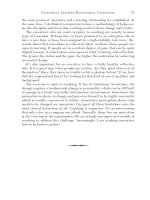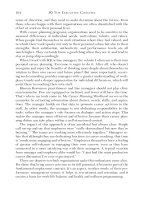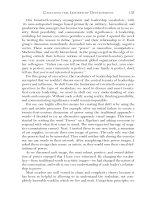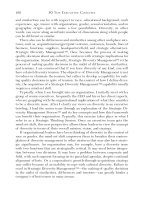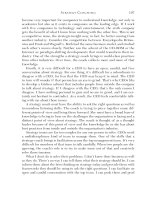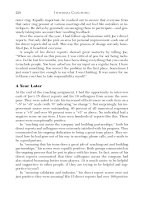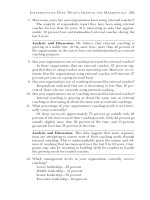Art and science of leadership 6th edition afsaneh nahavandi test bank
Bạn đang xem bản rút gọn của tài liệu. Xem và tải ngay bản đầy đủ của tài liệu tại đây (200.41 KB, 22 trang )
2-1
Chapter 2: The Global and Cultural Contexts
Multiple Choice Questions
1.
is the norms, customs, values, and assumptions that guide the behavior of a particular
group of people.
a. Culture
b. Leadership
c. Diversity
d. Individualism
(a; Easy; p. 29) (AACSB: Multicultural and Diversity)
2. Culture is important because:
a. some cultures are more powerful than others
b. culture guides people’s assumptions and behaviors
c. culture can be changed to match the organization
d. Leaders must learn to ignore culture
(b; Moderate; p. 29) (AACSB: Multicultural and Diversity)
3. How many levels does culture have?
a. two
b. three
c. four
d. five
(b; Easy; p. 34) (AACSB: Multicultural and Diversity)
4. People in who live in the ‘Little Italy’ region of New York City have maintained traditions, norms
and customs from generation to generation. This is an example of what level of culture?
a. Global
b. National
c. Cultural Groups
d. Organizational
(c; Moderate; p. 32)
5.
refers to the variety of human structures, belief systems, and strategies for
adapting to situations that exist within different groups.
a. Masculinity
b. Leadership
c. Gender
d. Diversity
(d; Challenging; p. 31) (AACSB: Multicultural and Diversity)
6. Male traits of ___________ and __________ are often associated with leadership in many cultures.
a. aggression; independence
b. intelligence; goal orientation
c. cognitive skills; ruthlessness
d. individualism; competition
(a; Moderate; p. 32) (AACSB: Multicultural and Diversity)
Copyright © 2012 Pearson Education, Inc. Publishing as Prentice Hall
2-2
7. The problems faced by the New York Times newspaper have been attributed to:
a. Jason Blair’s unethical behavior
b. the culture of the organization
c. the lack of challenging performance expectations
d. the national culture
(b; Challenging; p. 32)
8. The leadership at the New York Times newspaper created culture that focused on
a. the well being of employees
b. attention to ethical standards
c. careful promotion based on seniority
d. performance at all costs
(d; Challenging; p. 32)
9. David Peterson, CEO of North Highland created an organizational culture that:
a. took into consideration the employees’ personal life
b. separated personal and organizational goals
c. allowed for excellent financial performance
d. rewarded top financial performance
(a; Challenging; p. 32)
10. The examples of North Highland and Lander International are similar in that in both cases:
a. employees came first
b. financial performance came first
c. the leaders shaped the culture
d. national culture influenced organizational culture
(c; Challenging; p. 35)
11. David Peterson, CEO of North Highland, established a value of balancing work life and home life
within the company. This is an example of which level of culture?
a. Organizational
b. Cultural Groups
c. National
d. Leadership
(a; Challenging; p. 32)
12. The example of President Vincente Fox of Mexico stating: “I believe there are no mistakes”
illustrates:
a. his leadership style
b. the influence of the Mexican culture on leadership
c. the economic and political situation in Mexico
d. the impact of organizational factors on leadership
(b; Challenging; p. 32) (AACSB: Multicultural and Diversity)
13. National organizational heritage refers to:
a. the wealth of each organization
b. the culture of different organizations
c. the management styles based on national cultures
d. organizational events that shape national culture
(c; Challenging; p. 32) (AACSB: Multicultural and Diversity)
Copyright © 2012 Pearson Education, Inc. Publishing as Prentice Hall
2-3
14. The High and Low Context model of culture was developed by:
a. Hall
b. Trompenaars
c. Hosftede
d. GLOBE
(a; Challenging; p. 32) (AACSB: Multicultural and Diversity)
15. The High and Low Context model of culture addresses:
a. different cultural values
b. differences in communication styles
c. differences in leadership patterns
d. the organizational cultural context
(b; Challenging; p. 32) (AACSB: Multicultural and Diversity)
16. Leaders in high-context cultures may interpret the low-context followers’ directness as
.
a. an indication of effective leadership
b. a sign of a valuable employee
c. a display of respect
d. a lack of respect
(d; Challenging; p. 33) (AACSB: Multicultural and Diversity)
17. Which of the following cultures is NOT considered a low-context culture?
a. Germans
b. French
c. North Americans
d. Korean
(d; Challenging; p. 37) (AACSB: Multicultural and Diversity)
18. Which of the following cultures is NOT considered a high-context culture?
a. Japanese
b. African American
c. Korean
d. Scandinavian
(d; Challenging; p. 37) (AACSB: Multicultural and Diversity)
19. People from high context cultures typically:
a. rely on non-verbal cues and situational factors to communicate
b. rely on the written word and clearly stated statement to communicate
c. value leaders who take care of people
d. value leaders who focus on the task
(a; Challenging; p. 32) (AACSB: Multicultural and Diversity) (AACSB: Communication)
20. People from low context cultures typically:
a. rely on non-verbal cues and situational factors to communicate
b. rely on the written word and clearly stated statement to communicate
c. value leaders who take care of people
d. value leaders who focus on the task
(b; Challenging; p. 37) (AACSB: Multicultural and Diversity) (AACSB: Communication)
Copyright © 2012 Pearson Education, Inc. Publishing as Prentice Hall
2-4
21. The fact that the Vietnamese and Italians pay attention to a leader’s title and do not always rely on
written contracts can be partially attributed to:
a. the two cultures being relaxed
b. the two cultures being people oriented
c. the two cultures being high-context
d. the two cultures being collectivist
(c; Challenging; p. 37) (AACSB: Multicultural and Diversity)
22. A U.S. manager who is negotiating in China has difficulty getting his Chinese counterparts to agree to
put the details of their new contract on paper. At the same time, the Chinese managers are frustrated
at the U.S. manager’s insistence to clarify every detail. This conflict is can be partially attributed to:
a. the U.S. superiority in business interactions
b. the Chinese not trusting the U.S. manager
c. the difference in how the two cultures use context
d. the differences in the two countries political systems
(c; Challenging; p. 37) (AACSB: Multicultural and Diversity) (AACSB: Reflective Thinking)
23. A Mexican manager is upset at the fact that his German colleague jumps right into business without
taking the time to get to know him and establish a relationship. The German manager is frustrated at
how long it takes to get anything done and is pushing for quicker decision making. This cultural
conflict can be partially explained by:
a. the typical impatience of the Germans
b. the Mexican’s longer time orientation
c. the fact that Mexico is high context and Germany is low context
d. the typical cultural differences between Western Europe and Latin America
(c; Challenging; p. 37) (AACSB: Multicultural and Diversity) (AACSB: Reflective Thinking)
24. Which of the following is NOT one of Hofstede’s five dimensions of culture?
a. Uncertainty avoidance
b. Individualism
c. Time Orientation
d. People Orientation
(d; Challenging; p. 33) (AACSB: Multicultural and Diversity)
25. Which of the items is one of Hofstede’s five dimensions of culture?
a. Power distance
b. Egalitarian
c. High context
d. Performance orientation
(a; Challenging; p. 33) (AACSB: Multicultural and Diversity)
26.
power distance indicates that employees would generally accept work assignments from
their supervisors without question, whereas a
power distance indicates that employees
generally have about the same amount of power as their boss.
a. High; high
b. High; low
c. Low; high
d. Low; low
(b; Challenging; p. 33) (AACSB: Multicultural and Diversity) (AACSB: Reflective Thinking)
Copyright © 2012 Pearson Education, Inc. Publishing as Prentice Hall
2-5
27. According to Hofstede’s research on the dimensions of culture, the United States is best described
as_____.
a. above average on power distance and masculinity.
b. above average on power distance and below average on masculinity
c. below average on power distance and above average on masculinity
d. below average on both power distance and masculinity
(c; Challenging; p. 34) (AACSB: Multicultural and Diversity)
28. Compared to the United States, Japanese culture tends to be
.
a. higher on power distance and uncertainty avoidance
b. higher on power distance but lower on uncertainty avoidance
c. lower on power distance but higher on uncertainty avoidance
d. lower on both power distance and uncertainty avoidance
(a; Challenging; p. 34) (AACSB: Multicultural and Diversity)
29. Leaders in high power distance cultures would be most characterized by:
a. expecting feedback from employees
b. relying on formal structures to accomplish tasks
c. seeking notoriety for the organization
d. focusing on team efforts
(b; Challenging; p. 34) (AACSB: Multicultural and Diversity)
30. Leaders from individualistic cultures would best be characterized by
a. engaging in team-oriented activities
b. seeking recognition
c. demonstrating high levels of participation behaviors
d. employing supportive leader behaviors
(b; Challenging; p. 38) (AACSB: Multicultural and Diversity)
.
31. Which one of the following is not one of Hofstede’s cultural dimensions?
a. time orientation
b. power distance
c. uncertainty avoidance
d. egalitarianism
(d; Challenging; p. 38) (AACSB: Multicultural and Diversity)
32. Geert Hofstede developed his cultural values model based on surveys of:
a. managers in the European Union
b. IBM employees in 40 countries
c. North American and Canadian managers
d. Students in introductory psychology classes
(b; Challenging; p. 38) (AACSB: Multicultural and Diversity)
33. Hofstede’s model includes how many cultural dimensions?
a. two
b. four
c. five
d. seven
(c; Challenging; p. 38) (AACSB: Multicultural and Diversity)
Copyright © 2012 Pearson Education, Inc. Publishing as Prentice Hall
2-6
34. Power distance refers to:
a. how much power managers have
b. the extent to which people accept unequal power
c. the power of the leaders to make changes without consulting followers
d. how paternalistic and male dominated a society is
(b; Challenging; p. 38) (AACSB: Multicultural and Diversity)
35. French employees typically do not expect to participate in decision making to the same extent as U.S.
or Swedish employees. This may be partially because:
a. France is a high power distance culture
b. U.S. and Swedish employees are often better trained
c. France is less collectivistic that the U.S. or Sweden
d. the French are not comfortable with uncertainty
(a; Challenging; p. 38) (AACSB: Multicultural and Diversity)
36. Tolerance of uncertainty refers to:
a. how much uncertainty exists in the political system
b. how quickly managers make decisions
c. the extent to which employees rely on their manager for decision making
d. how comfortable people are with ambiguity
(d; Challenging; p. 38) (AACSB: Multicultural and Diversity)
37. When a culture is high in uncertainty avoidance, people are likely to:
a. search for absolute truths
b. expect their leaders to allow participation
c. rely on their community for information
d. have a short term orientation
(a; Challenging; p. 34) (AACSB: Multicultural and Diversity)
38. Individualistic cultures tend to:
a. expect people to conform to social norms before they become independent
b. emphasize performance over social support
c. focus on individual achievement
d. value material goods
(c; Challenging; p. 38) (AACSB: Multicultural and Diversity)
39. Although many companies in the U.S. have adopted team-based management that is very successful
in Japan, U.S. managers and employees often have difficulty working in teams. This may be because:
a. Japanese managers are generally superior in motivating their employees
b. the U.S. employees are not comfortable with uncertainty
c. the Japanese have lower power distance and are more egalitarian
d. the U.S. employees are more individualistic
(d; Challenging; p. 34) (AACSB: Multicultural and Diversity) (AACSB: Reflective Thinking)
40. Based on Hofstede’s model, which of the following best describes the culture of the U.S.?
a. The U.S. is an individualistic culture where people are long-term oriented, value
achievement and are highly competitive.
b. The U.S. culture places a high value on individuals and achievement and tends to be
egalitarian and short-term orientated with low power distance.
c. The U.S. is highly competitive, power oriented, and focused on improving social justice.
d. The U.S. culture is high on context, power, achievement, and competitiveness.
Copyright © 2012 Pearson Education, Inc. Publishing as Prentice Hall
2-7
(b; Challenging; p. 38) (AACSB: Multicultural and Diversity)
41. Japanese culture is characterized with strong feelings toward group with clear rank and status
differentiation as well as an obligation to obey authority. This is best described as which combination
of Triandis characteristics of culture?
a. individualistic and vertical
b. individualistic and horizontal
c. collectivistic and vertical
d. collectivistic and horizontal
(c; Challenging; p. 34) (AACSB: Multicultural and Diversity) (AACSB: Reflective Thinking)
42. Harry Triandis proposes that the concept of uncertainty avoidance can be further refined by:
a. adding the concept of time orientation to tolerance for uncertainty.
b. looking at how uncertainty avoidance is different in vertical and horizontal cultures.
c. introducing the concept of tight and loose cultures to uncertainty avoidance.
d. combining context and individuality to explain uncertainty avoidance.
(c; Challenging; p. 34) (AACSB: Multicultural and Diversity)
43. In Thailand, there is much tolerance for behaviors that are considered acceptable and violation of
rules is often overlooked. This can partly be explained because:
a. Thailand has a loose culture.
b. Thailand is collectivistic.
c. Thailand emphasizes consideration for individual rights
d. Thailand is a low power distance culture.
(a; Challenging; p. 34) (AACSB: Multicultural and Diversity) (AACSB: Reflective Thinking)
44. Mehran has grown up in a culture where breaking rules and norms of behavior is considered to be
serious. Her parents and teachers often reminded her that rules are to be obeyed and that she risked
serious consequences if she did not conform. Based on this information, one could deduce that
Mehran’s culture is:
a. very harsh.
b. high power distance.
c. a tight culture.
d. ascriptive and collectivistic.
(c; Challenging; p. 34) (AACSB: Multicultural and Diversity) (AACSB: Reflective Thinking)
45. The concept of individualism/collectivism can be further refined by considering:
a. whether leaders have power and how they use power.
b. how tight or loose the culture is.
c. whether followers make decisions on their own.
d. whether the culture focuses on hierarchy or equality.
(d; Challenging; p. 39) (AACSB: Multicultural and Diversity)
46. _________ cultures focus on hierarchy; while _________ cultures focus on equality.
a. Vertical; horizontal
b. Tight; loose
c. Ascriptive; prescriptive
d. Collectivistic; individualistic
(a; Challenging; p. 39) (AACSB: Multicultural and Diversity)
47. In vertical individualistic cultures:
Copyright © 2012 Pearson Education, Inc. Publishing as Prentice Hall
2-8
a. all members of the groups are seen as equal.
b. the individual is seen as unique and superior to others.
c. individuals must sacrifice themselves for the group.
d. the individual is unique but equal to others.
(b; Challenging; p. 34) (AACSB: Multicultural and Diversity)
48. In horizontal individualist cultures:
a. all members of the groups are seen as equal.
b. the individual is seen as unique and superior to others.
c. individuals must sacrifice themselves for the group.
d. the individual is unique but equal to others.
(d; Challenging; p. 34) (AACSB: Multicultural and Diversity)
49. In vertical collectivistic cultures:
a. all members of the groups are seen as equal.
b. the individual is seen as unique and superior to others.
c. individuals must sacrifice themselves for the group.
d. the individual is unique but equal to others.
(c; Challenging; p. 39) (AACSB: Multicultural and Diversity)
50. Japan and Korea are examples of __________.
a. loose cultures
b. individualistic cultures
c. vertical collectivistic cultures
d. cultures that are comfortable with uncertainty
(c; Challenging; p. 39) (AACSB: Multicultural and Diversity)
51. Vertical/horizontal dimension impacts leadership because:
a. it deals with people
b. it relates to how rules are used
c. it focuses on how leaders use participation in their culture
d. it affects views of hierarchy and equality
(d; Challenging; p. 39) (AACSB: Multicultural and Diversity)
52.
are egalitarian and focus on taking care of individual needs.
a. incubator cultures
b. guided missiles
c. family
d. Eiffel Tower
(a; Challenging; p. 35) (AACSB: Multicultural and Diversity)
53. Christie works in organization that focuses heavily and team interaction and job performance. Which
of the Trompenaar’s cultures best describes her organization?
a. incubator
b. guided missile
c. family
d. Eiffel Tower
(b; Challenging; p. 36) (AACSB: Multicultural and Diversity)
54. According to Trompenaar’s dimensions of culture, the Eiffel Tower organization focuses on:
a. taking care of individual needs and individual growth
Copyright © 2012 Pearson Education, Inc. Publishing as Prentice Hall
2-9
b. hierarchy and tasks
c. taking care of families
d. egalitarianism and performance orientation
(b; Challenging; p. 36) (AACSB: Multicultural and Diversity)
55. An organization that defines their culture by having strong, powerful leaders that take care of the
needs of individuals in the organization is best characterized as
.
a. incubator culture
b. guided missile
c. family
d. Eiffel tower
(c; Challenging; p. 40-41) (AACSB: Multicultural and Diversity)
56. Effective leaders in an organization with a family culture are best described as:
a. demonstrating a team-orientation
b. committee to individual achievement
c. making use of formal authority to accomplish tasks
d. uses limited participation behaviors
(a; Challenging; p. 40) (AACSB: Multicultural and Diversity)
57. Leaders in organizations characterized as an incubator culture effectively demonstrate all of the
following behaviors except?
a. focusing on individual growth
b. engaging in team-oriented behaviors
c. removing obstacles and provides necessary resources
d. demonstrating considerable expertise and competence
(b; Challenging; p. 40) (AACSB: Multicultural and Diversity)
58. As opposed to Hofstede who considers general cultural dimensions and values, Trompenaars and his
colleagues have developed model that:
a. looks at power relationships inside of organizations
b. focuses on how national culture affects corporate cultures
c. allows managers to understand the motivation of their followers
d. considers the communication context within organizations
(b; Challenging; p. 40) (AACSB: Multicultural and Diversity)
59. The two dimensions used by Trompenaars to classify cross-cultural organizational cultures include:
a. egalitarian-hierarchical and person-task
b. tight-loose and vertical-horizontal
c. proactive and reactive
d. high context and low context
(a; Challenging; p. 40) (AACSB: Multicultural and Diversity)
60. Which one of the following is not one of Trompenaars cross-cultural organizational cultures?
a. incubator
b. guided missile
c. community
d. Eiffel tower
(c; Challenging; p. 40) (AACSB: Multicultural and Diversity)
61. According to Trompenaars, incubators are:
Copyright © 2012 Pearson Education, Inc. Publishing as Prentice Hall
2-10
a. egalitarian and focused on taking care of individual needs.
b. egalitarian and focused on the task.
c. hierarchical and focused on taking care of people.
d. hierarchical and driven to accomplish tasks.
(a; Challenging; p. 40) (AACSB: Multicultural and Diversity)
62. Steve is searching for a new job. He recognizes that he is most comfortable in organizations that
posses clear organizational structures, well defined roles and focus on ‘getting the job done.’ Which
type of organization would be the best fit for Steve?
a. Eiffel Tower
b. guided missile
c. incubator
d. family
(a; Challenging; p. 40-41) (AACSB: Multicultural and Diversity) (AACSB: Reflective Thinking)
63. According to Trompenaars, guided missiles are:
a. egalitarian and focused on taking care of individual needs.
b. egalitarian and focused on the task.
c. hierarchical and focused on taking care of people.
d. hierarchical and driven to accomplish tasks.
(b; Challenging; p. 41) (AACSB: Multicultural and Diversity)
64. Jerry is working in an organization where people are very relaxed and there are few rules and
hierarchy. However, getting the task done is everyone’s primary concern. The cross-cultural
organizational culture of Jerry’s company can be best classified as:
a. guided missile
b. individualistic and task oriented
c. organic
d. family style
(a; Challenging; p. 41) (AACSB: Multicultural and Diversity) (AACSB: Reflective Thinking)
65. Nigel has a new job and during orientation he is told that the organization treats employees as
professionals and gives them considerable latitude. He is also told that leadership is based on
competence and expertise. Based on this description, Nigel is most likely working for which type of
organization?
a. guided missile
b. incubator
c. Eiffel tower
d. Family
(b; Challenging; p. 41) (AACSB: Multicultural and Diversity) (AACSB: Reflective Thinking)
66. The GLOBE project includes information about cross-cultural difference from how many cultures?
a. close to 300
b. over 100
c. around 60
d. about 20
(c; Challenging; p. 36) (AACSB: Multicultural and Diversity)
67. Based on GLOBE findings the U.S. is among the highest on:
a. power distance and tolerance ambiguity
b. humane orientation and performance
Copyright © 2012 Pearson Education, Inc. Publishing as Prentice Hall
2-11
c. gender egalitarianism and individuality
d. assertiveness and performance
(d; Challenging; p. 37) (AACSB: Multicultural and Diversity)
68. Which of the following is NOT one of the nine dimensions on the GLOBE study?
a. Stability
b. Power distance
c. Uncertainty avoidance
d. Performance orientation
(a; Challenging; p. 41-42) (AACSB: Multicultural and Diversity)
69. Based on the GLOBE study, Germany was found to be:
a. High for both assertiveness and uncertainty avoidance
b. High assertiveness and low uncertainty avoidance
c. Low assertiveness and high uncertainty avoidance
d. Low on both assertiveness and uncertainty avoidance
(a; Challenging; p. 37) (AACSB: Multicultural and Diversity)
70. One of the contributions of the GLOBE research has been:
a. more dimensions to explain culture
b. identification of universal and culturally contingent leader behaviors
c. the clarification of the dimensions presented by other researchers such as Hofstede and
Trompenaars
d. to recognize autonomy and assertiveness as key universal leadership styles
(b; Challenging; p. 41-42) (AACSB: Multicultural and Diversity)
71. Which country is likely to be described as having the greatest gender differentiation?
a. Egypt
b. United States
c. Sweden
d. Italy
(a; Challenging; p. 42) (AACSB: Multicultural and Diversity)
72. The GLOBE study found which country to be the least focused on a future orientation?
a. Singapore
b. Russia
c. United States
d. Australia
(b; Challenging; p. 42) (AACSB: Multicultural and Diversity)
73. Which best describes a county characterized with a high power distance?
a. communication is typically directed only one way
b. there is a free flow of communication between leaders and followers
c. feedback is expected from followers
d. individuals will rarely rely on nonverbal cues
(a; Challenging; p. 42) (AACSB: Multicultural and Diversity)
74. The GLOBE study found which of the following leadership behaviors to be desirable across most
cultures?
a. autocratic leadership
b. charismatic/values-based leadership
Copyright © 2012 Pearson Education, Inc. Publishing as Prentice Hall
2-12
c. directive leadership
d. achievement orientated
(b; Challenging; p. 38) (AACSB: Multicultural and Diversity)
75.
is the degree to which a culture values fairness, generosity, caring and kindness.
a. uncertainty avoidance
b. in-group collectivism
c. future orientation
d. humane orientation
(d; Challenging; p. 42) (AACSB: Multicultural and Diversity)
76. According to the GLOBE study, Institutional Collectivism refers to:
a. The degree to which the culture values collective action and collective distribution of
resources
b. The degree to which the culture values task completion and excellence
c. The degree to which the culture invests in the future rather than the present or past
d. The degree to which the culture values fairness, generosity and kindness
(a; Challenging; p. 42) (AACSB: Multicultural and Diversity)
77. Which set of countries like certainty more than others?
a. Russia and Venezuela
b. United States and Mexico
c. China and Japan
d. Denmark and Germany
(d; Challenging; p. 42) (AACSB: Multicultural and Diversity)
78. Which set of countries like assertiveness more than the others?
a. United States and Germany
b. France and Philippines
c. Japan and Kuwait
d. Egypt and China
(a; Challenging; p. 42) (AACSB: Multicultural and Diversity)
79.
can be described as having a high level of gender differentiation, whereas
is described as having a low level of gender differentiation.
a. United States; India
b. Canada; South Korea
c. Taiwan; China
d. Egypt; Sweden
(d; Challenging; p. 42) (AACSB: Multicultural and Diversity)
80. Which one of the following is not one of the GLOBE dimensions?
a. collectivism
b. assertiveness
c. emotionality
d. future orientation
(c; Challenging; p. 42) (AACSB: Multicultural and Diversity)
81. The difference between Collectivism I and Collectivism II in the GLOBE cultural dimensions is
related to:
a. focus on people or social systems
Copyright © 2012 Pearson Education, Inc. Publishing as Prentice Hall
2-13
b. the degree of assertiveness of the individual versus the group
c. the degree to which performance is based on the group or the organization
d. focus on social institutions or family and organizations
(d; Challenging; p. 42) (AACSB: Multicultural and Diversity)
82. According to the GLOBE findings ___________ is generally valued in most cultures.
a. team-based leadership
b. directive leadership
c. self-protective leadership
d. active and assertive leadership
(a; Challenging; p. 42) (AACSB: Multicultural and Diversity)
83. The GLOBE study found Americans and British highly value
place
importance on it.
a. collectivism; low
b. participation; high
c. charisma; low
d. high power distance; low
(c; Challenging; p. 43) (AACSB: Multicultural and Diversity)
and Middle Easterners
84. Which of the following is not a recommendation for managing culture effectively in an organization?
a. Understand the culture of your organization
b. Recruit and hire employees only from organization’s national culture
c. Build upon agreements
d. Evaluate disagreements
(b; Challenging; p. 43) (AACSB: Multicultural and Diversity)
85. In the United States in 2007, women held 40-50 percent of supervisory jobs, but only
of corporate officer positions.
a. 35
b. 25
c. 15
d. 5
(c; Challenging; p. 40) (AACSB: Multicultural and Diversity)
percent
86. A 2006 study indicated that
of Fortune 500 companies’ CEO positions were held by women.
a. 3.0 percent
b. 4.5 percent
c. 9.2 percent
d. 15.4 percent
(a; Challenging; p. 40) (AACSB: Multicultural and Diversity)
87. If current trends continue, only what percent of women will hold top leadership positions in the year
2016?
a. 2.3 percent
b. 6.0 percent
c. 8.9 percent
d. 12.5 percent
(b; Challenging; p. 40) (AACSB: Multicultural and Diversity)
Copyright © 2012 Pearson Education, Inc. Publishing as Prentice Hall
2-14
88. The salary gap between men and women is evidence of the challenges women face. In 2006 study,
compared to the top ten, highest paid, male CEOs made how much more than the top ten female
counterparts?
a. one to two times more
b. two to three times more
c. four to five times more
d. ten times more
(b; Challenging; p. 40) (AACSB: Multicultural and Diversity)
89. Eagly and Johnson found that women tend to use
leadership style whereas men tended to use
leadership style.
a. masculine; feminine
b. autocratic; transformational
c. people-oriented; task focused
d. task oriented; people oriented
(c; Challenging; p. 41) (AACSB: Multicultural and Diversity)
90. According to Eagly and her colleagues in the 2003 study, what is the likely reason why female
leaders are more transformational than male leaders?
a. men are more supportive of their followers
b. women are more task-oriented
c. women are more directive
d. women show more individual attention to followers
(d; Challenging; p. 41) (AACSB: Multicultural and Diversity) challenging
91. The invisible barrier and obstacles that prevent women from moving to the highest levels of the
organization is called?
a. glass elevator
b. glass roof
c. glass basement
d. glass ceiling
(d; Challenging; p. 43) (AACSB: Multicultural and Diversity)
92. Many professional women do take a break from work to start a family. Over
women try to get back to work within two years.
a. 50
b. 60
c. 70
d. 90
(d; Challenging; p. 43) (AACSB: Multicultural and Diversity)
percent of
93. Women who demonstrate masculine leadership styles are?
a. more likely to be considered effective by men
b. more likely to be evaluated poorly by men
c. demonstrating what is expected of them by men
d. more respected by both men and women
(b; Challenging; p. 48) (AACSB: Multicultural and Diversity)
94. According to the U.S. Equal Employment Opportunity Commission 2009 report, 12,700 sexual
harassment complaints were filed in 2009. How many were filed by men?
a. 16 percent
Copyright © 2012 Pearson Education, Inc. Publishing as Prentice Hall
2-15
b. 23 percent
c. 35 percent
d. 47 percent
(a; Challenging; p. 44) (AACSB: Multicultural and Diversity)
95. The primary goal of multiculturalism is to? (p. 50)
a. issue quotas and percentages
b. build a culture of openness and inclusion
c. create an organization of autocratic leadership
d. establish barriers in hiring of women and minorities
(b; Challenging; p. 50) (AACSB: Multicultural and Diversity)
96. A Gallup survey reported a link between diversity to what organizational outcome? (p. 50)
a. increase in employee dissatisfaction
b. increase in employee satisfaction
c. increase in employee performance
d. increase in employee stereotyping
(b; Challenging; p. 50) (AACSB: Multicultural and Diversity)
True/False Questions
97. Culture is shared by members of a group.
a. true
b. false
(a; Challenging; p. 29) (AACSB: Multicultural and Diversity)
98. Culture consists of the commonly held values of a group of people.
a. true
b. false
(a; Challenging; p. 29) (AACSB: Multicultural and Diversity)
99. National culture is the set of values and beliefs shared by people within a nation.
a. true
b. false
(a; Challenging; p. 34) (AACSB: Multicultural and Diversity)
100.
Ethnic or group culture is the set of values and beliefs shared by cultures within a nation.
a. true
b. false
(a; Challenging; p. 31) (AACSB: Multicultural and Diversity)
101.
Organizational culture is the set of values and beliefs shared by members of an organization.
a. true
b. false
(a; Challenging; p. 35) (AACSB: Multicultural and Diversity)
102.
While traditional male traits are often associated with leadership, this is changing because of new
organizational models.
a. true
b. false
Copyright © 2012 Pearson Education, Inc. Publishing as Prentice Hall
2-16
(b; Challenging; p. 35) (AACSB: Multicultural and Diversity)
103.
Culture exists only at the national level.
a. true
b. false
(b; Challenging; p. 34) (AACSB: Multicultural and Diversity)
104.
Diversity refers to the variety of human structures, belief systems, and strategies for adapting to
situations that exist within different groups.
a. true
b. false
(a; Challenging; p. 34) (AACSB: Multicultural and Diversity)
105.
Gender differences is an example of national culture.
a. true
b. false
(b; Challenging; p. 34) (AACSB: Multicultural and Diversity)
106.
People learn culture through both formal teaching and informal observation.
a. true
b. false
(a; Challenging; p. 35) (AACSB: Multicultural and Diversity)
Culture mostly affects people’s personal life, rather than leadership.
a. true
b. false
(b; Challenging; p. 35) (AACSB: Multicultural and Diversity)
107.
108.
Organizational culture influences leadership to a greater extent than national culture.
a. true
b. false
(a; Challenging; p. 35) (AACSB: Multicultural and Diversity)
109.
Diversity includes any characteristic that may differentiate one group from another.
a. true
b. false
(a; Challenging; p. 35) (AACSB: Multicultural and Diversity)
110.
Organizational culture is the set of norms, values and beliefs shared by members of a nation.
a. true
b. false
(b; Challenging; p. 35) (AACSB: Multicultural and Diversity)
111.
Leaders and organizational founders play a key role in the development of the culture of an
organization.
a. true
b. false
(a; Challenging; p. 31)
112.
The leadership at the New York Times newspaper focused on creating a culture that balanced
employee needs and well being with organizational performance goals.
Copyright © 2012 Pearson Education, Inc. Publishing as Prentice Hall
2-17
a. true
b. false
(b; Challenging; p. 31)
113.
At the North Highland company and Lander International, leaders placed particular attention to
employee needs.
a. true
b. false
(a; Challenging; p. 31)
114.
North Highland, Lander International, and Atlantic Group Furniture define the leadership
effectiveness in the same manner.
a. true
b. false
(b; Challenging; p. 35)
115.
National organizational heritage refers to management styles based on national cultures.
a. true
b. false
(a; Challenging; p. 36) (AACSB: Multicultural and Diversity)
116.
High context cultures rely heavily on situational aspects such as nonverbal cues to understand the
world around them.
a. true
b. false
(a; Challenging; p. 37) (AACSB: Multicultural and Diversity)
117.
The United States is generally considered a high-context culture.
a. true
b. false
(b; Challenging; p. 33) (AACSB: Multicultural and Diversity)
118.
Japanese, Chinese and Native American cultures are commonly considered low-context cultures.
a. true
b. false
(b; Challenging; p. 37) (AACSB: Multicultural and Diversity)
119.
The High and Low Context model of culture addresses differences in communication styles
among different cultures.
a. true
b. false
(a; Challenging; p. 32-33) (AACSB: Multicultural and Diversity)
120.
According the research conducted by Hofstede, Japanese culture has a higher level of power
distance than the United States.
a. true
b. false
(a; Challenging; p. 33) (AACSB: Multicultural and Diversity)
121.
Compared to the United States, Japanese culture has a shorter-time orientation.
a. true
Copyright © 2012 Pearson Education, Inc. Publishing as Prentice Hall
2-18
b. false
(b; Challenging; p. 33) (AACSB: Multicultural and Diversity)
You can usually understand a country’s culture by using one of Hofstede’s cultural dimensions.
a. true
b. false
(b; Challenging; p. 38) (AACSB: Multicultural and Diversity)
122.
123.
In high power distance cultures, there is a wider gap between the powerful and the powerless.
a. true
b. false
(a; Challenging; p. 38) (AACSB: Multicultural and Diversity)
124.
In individualistic cultures, people rely on their group for guidance.
a. true
b. false
(b; Challenging; p. 38) (AACSB: Multicultural and Diversity)
125.
The U.S. and Australia are among the most individualistic cultures in the world.
a. true
b. false
(a; Challenging; p. 38) (AACSB: Multicultural and Diversity)
126.
In Japan, while collectivism is very high and people place value on consensus, there is also high
power distance.
a. true
b. false
(a; Challenging; p. 38) (AACSB: Multicultural and Diversity)
Triandis describes Sweden’s culture as being both individualistic and emphasizing equality.
a. true
b. false
(a; Challenging; p. 34) (AACSB: Multicultural and Diversity)
127.
128.
Collectivist and vertical cultures tend to consider all group members equal with little hierarchy.
a. true
b. false
(b; Challenging; p. 39) (AACSB: Multicultural and Diversity)
129.
Harry Triandis is the person who originally proposed the concept of uncertainty avoidance.
a. true
b. false
(a; Challenging; p. 39) (AACSB: Multicultural and Diversity)
130.
While Sweden and the U.S. are both individualistic cultures, in Sweden individuals are seen as
unique and superior to others, while in the U.S., equality is the norm.
a. true
b. false
(b; Challenging; p. 33) (AACSB: Multicultural and Diversity)
Copyright © 2012 Pearson Education, Inc. Publishing as Prentice Hall
2-19
131.
According to Trompenaars, family type organizations are found most often in countries such as
Greece, Singapore, and Japan.
a. true
b. false
(a; Challenging; p. 36) (AACSB: Multicultural and Diversity)
132.
Incubator cultures that focus on equality in organizations give considerable latitude and flexibility
to their members.
a. true
b. false
(a; Challenging; p. 40) (AACSB: Multicultural and Diversity)
133.
The leader’s role in an incubator cross-cultural organizational culture is to be the undisputed head
and take full responsibility for all that occurs.
a. true
b. false
(b; Challenging; p. 40) (AACSB: Multicultural and Diversity)
134.
The GLOBE cultural model uses nine dimensions to understand and explain culture.
a. true
b. false
(a; Challenging; p. 36) (AACSB: Multicultural and Diversity)
135.
All the dimensions proposed by the GLOBE model are new and different from those presented by
other researchers.
a. true
b. false
(b; Challenging; p. 41-42) (AACSB: Multicultural and Diversity)
136.
In assertive cultures individuals are direct and confrontational.
a. true
b. false
(a; Challenging; p. 36-37) (AACSB: Multicultural and Diversity)
137.
Future oriented cultures tend to take a long-term orientation that ties the present to the past and
future.
a. true
b. false
(b; Challenging; p. 42) (AACSB: Multicultural and Diversity)
138.
The GLOBE study found some leader behaviors to be nearly universally desirable.
a. true
b. false
(a; Challenging; p. 38) (AACSB: Multicultural and Diversity)
139.
Achievement-oriented leadership was found to be widely desirable leadership behavior across
most cultures according to the GLOBE study.
a. true
b. false
(b; Challenging; p. 42) (AACSB: Multicultural and Diversity)
Copyright © 2012 Pearson Education, Inc. Publishing as Prentice Hall
2-20
140.
There has actually been a decrease in the percentage of superintendent positions held by women
between 1910 and 1990.
a. true
b. false
(a; Challenging; p. 41) (AACSB: Multicultural and Diversity)
141.
Women tend to show more autocratic leadership styles than men.
a. true
b. false
(b; Challenging; p. 42) (AACSB: Multicultural and Diversity)
142.
Female leaders demonstrate more transformational leadership characteristics than men.
a. true
b. false
(a; Challenging; p. 42) (AACSB: Multicultural and Diversity)
143.
Tom Peters believes that the success depends on the collaborative styles that women tend to use
instead of the command and control style that male leaders have traditionally used.
a. true
b. false
(a; Challenging; p. 47) (AACSB: Multicultural and Diversity)
144.
Characteristics typically associated with female leadership styles are becoming less necessary.
a. true
b. false
(b; Challenging; p. 42) (AACSB: Multicultural and Diversity)
145.
Women who take a break from work when they start a family often try to get back to work within
two years.
a. true
b. false
(a; Challenging; p. 43) (AACSB: Multicultural and Diversity)
146.
Women who display typically masculine leadership characteristics are well accepted by and
evaluated highly by men.
a. true
b. false
(b; Challenging; p. 44) (AACSB: Multicultural and Diversity)
147.
Women always support other women getting leadership positions.
a. true
b. false
(b; Challenging; p. 49) (AACSB: Multicultural and Diversity)
148.
The recent changing views of what is considered effective leadership taking on more
stereotypically feminine traits.
a. true
b. false
(a; Challenging; p. 49) (AACSB: Multicultural and Diversity)
149.
Men experience and report experiencing sexual harassment just as often as women.
Copyright © 2012 Pearson Education, Inc. Publishing as Prentice Hall
2-21
a. true
b. false
(b; Challenging; p. 44) (AACSB: Multicultural and Diversity)
An organization’s leaders do not exert much influence to create an ethos of multiculturalism.
a. true
b. false
(b; Challenging; p. 50) (AACSB: Multicultural and Diversity)
150.
151.
A recent Gallup survey indicated there was no relationship between multiculturalism and overall
employee satisfaction.
a. true
b. false
(b; Challenging; p. 50) (AACSB: Multicultural and Diversity)
152.
The primary goal of training and education in multiculturalism is to help people understand that
quotas and percentages will help the organization become more culturally diverse.
a. true
b. false
(b; Challenging; p. 50-51) (AACSB: Multicultural and Diversity)
153.
Training and education can be an effective strategy for organizations to create an organizational
culture of openness and inclusion.
a. true
b. false
(a; Challenging; p. 51) (AACSB: Multicultural and Diversity)
154.
Changing evaluation criteria to ‘softer data’ can be an effective strategy for creating a more
multicultural organization.
a. true
b. false
(a; Challenging; p. 53)
155.
Traditional evaluation criteria emphasize stereotypically female characteristics.
a. true
b. false
(b; Challenging; p. 53) (AACSB: Multicultural and Diversity)
Short Answer/ Essay Questions:
156.
Atlanta-based consulting firm North Highland, established a “no-fly zone.” Explain what that
means.
(Moderate; p. 31)
157.
Compare the organizational cultures of Lander International, Goldman Sachs, and the New
York Times.
(Challenging; p. 31)
158.
Define Hofstede’s five dimensions that lends each national culture its distinctiveness and
unique character.
Copyright © 2012 Pearson Education, Inc. Publishing as Prentice Hall
2-22
(Easy; p. 33)
159.
Describe the management style, the “web,” used by Volunteer Board of America.
(Easy; p. 39)
160.
Explain what is meant by the statement that characteristics typically associated with the female
leadership style are increasingly considered necessary, regardless of gender.
(Easy; p. 42)
161.
Discuss what Ed Zander, former CEO of Motorola, means by: “Business and diversity are one
and the same. Business means diversity, and diversity means business” (Winters, 2007: 7).
(Moderate; p. 46)
162
Darla Moore, chief executive officer of the investment company
Rainwater, Inc., and the first woman to have a business school named after her, argues that
women’s worse sin is to think, “‘You should be a nice girl. You ought to fit in. You should find a
female mentor.’ What a colossal waste of time” (Sellers, 1998: 92). She contends, “There are
only glass ceilings and closed doors for those who allow such impediments” (Darla Moore
Speech, 2007). Investigate the Internet and explain what Ms. Moore meant by those statements and relate
what her leadership reputation at Rainwater is.
(Challenging; p. 46)
Copyright © 2012 Pearson Education, Inc. Publishing as Prentice Hall



